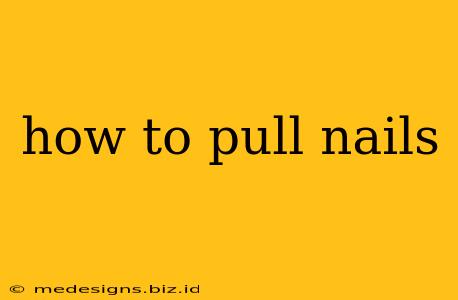Pulling nails can seem simple, but doing it correctly prevents damage to the surrounding wood and protects your hands. This guide covers various techniques and tools, ensuring you successfully remove nails without frustration.
Assessing the Situation: Nail Type and Wood Condition
Before you start yanking, take a moment to assess the situation. Different nails require different approaches.
Nail Type:
- Common Nails: These are the most common type, straight and relatively easy to remove.
- Finishing Nails: These are smaller and have a smaller head, making them trickier to grip.
- Bent or Rusted Nails: These present the biggest challenges and often require more force and specialized tools.
- Old Nails: Older nails can be brittle and prone to snapping, requiring extra care.
Wood Condition:
- Softwood: Easier to work with, less likely to split.
- Hardwood: More prone to splitting; requires gentler techniques.
- Damaged Wood: Exercise extreme caution to avoid further damage.
Essential Tools for Nail Pulling
The right tools make all the difference. Here’s what you’ll need:
- Claw Hammer: This is your primary tool. Choose one with a comfortable grip and well-maintained claws.
- Cat's Paw: This tool is specifically designed for nail removal and offers better leverage than a claw hammer in many situations, particularly with finishing nails.
- Nail Puller: A variety of specialized nail pullers exist for different nail types and situations. These are especially useful for bent nails or those in hard-to-reach places.
- Prying Bar: Useful for stubborn nails or those set deep in the wood. Use with caution to prevent wood damage.
- Safety Glasses: Protect your eyes from flying debris.
- Work Gloves: Protect your hands.
Techniques for Pulling Nails
Here’s a step-by-step guide for different scenarios:
Pulling Common Nails with a Claw Hammer:
- Position the Claw: Place the hammer claw's arms around the nail head, ensuring a firm grip.
- Apply Leverage: Rock the hammer gently to loosen the nail.
- Pull Straight Out: Pull the nail straight out, applying steady pressure. Avoid jerking or twisting.
Pulling Finishing Nails:
- Use a Cat's Paw: A cat's paw provides better leverage for these smaller nails.
- Gentle Rocking: Gently rock the cat's paw back and forth to loosen the nail.
- Controlled Extraction: Pull the nail straight out.
Dealing with Stubborn or Bent Nails:
- Penetrating Oil: Apply penetrating oil to loosen the nail. Allow it to sit for a few minutes.
- Claw Hammer and Prying Bar: Use the claw hammer for initial leverage, then use a prying bar for additional force.
- Nail Puller: A specialized nail puller might be necessary for severely bent or stubborn nails.
Preventing Wood Damage:
- Place a Block of Wood: Placing a block of wood under the claw of the hammer will prevent damage to the surrounding wood.
- Gentle Pressure: Apply consistent, gentle pressure rather than forceful yanks.
- Work Slowly: Take your time; rushing can lead to mistakes.
Safety First!
- Always wear safety glasses and work gloves. Flying debris and splinters can cause injury.
- Use the right tool for the job. Don't force a tool; you risk injury and damage.
- Be aware of your surroundings. Ensure the area is clear of obstructions.
- If a nail is particularly stubborn or you're uncomfortable, seek professional assistance.
By following these tips and techniques, you can confidently pull nails without causing damage or injuring yourself. Remember, patience and the right tools are key to success!
